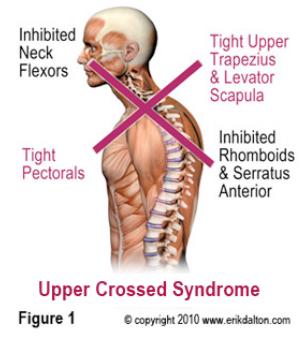Exercising with Upper Crossed Syndrome
Upper Crossed Syndrome (UCS) is a postural problem that starts with muscle imbalances between the muscles of the front and the back of the upper body. The shoulders round inward, the upper back starts to develop a rounded, hump-like appearance, and the head juts forward into Forward Head Posture. Tight muscles typically include the pectoralis major, the levator scapulae, the upper trapezius , latissimus dorsi, anterior deltoid, and the subscapularis (part of rotator cuff) . The weakened muscles include the rhomboids, posterior deltoid, lower trapezius, serratus anterior, deep cervical neck flexors, and the teres minor and infraspinatus (also part of the rotator cuff).
Upper Crossed Syndrome
A person with UCS will often have headaches, a feeling of extreme

tightness just below the base of the back of the skull and may notice that his shoulder blades are winging out. Other indicators may include sleep apnea, difficulty swallowing, clenched teeth and pain in the face and neck. If the person is experiencing a significant number of these signs, he can also do the Knuckle test. Standing in front of a mirror, he can look at his hands. If he can see the knuckles on his ring fingers, he has excessive internal shoulder rotation, and chances are very good that he has UCS.
This is a very common syndrome these days, thanks in large part to us spending extended periods of time staring at a computer screen, bent over a tablet, cell phone, or gaming system. What is the best way to train to avoid injury, while correcting the UCS?
It is important to strengthen the weak muscles and stretch the overly tight ones, to help restore postural balance to the upper body.
Corrective exercises to stabilize the scapulae, or shoulder blades may include rows, spinal rotation with extension, and isometric retraction and depression. Tubing or light dumbbells are the best choices for this. Once the shoulder blades are more stable, move on to doing internal and external shoulder rotation, either sidelying or standing. Exercises that should be avoided include barbell work, bilateral strength machines, all overhead presses, bench pressing with a pronated grip, upright rows, bench presses with more than a 30° bench angle, and any loaded movement behind the back.
Stretching the tight muscles is just as important as strengthening the weak ones. I recommend doing some self-myofascial release techniques (SMR), prior to static stretches. For instance, to help release the tight pectorals (chest muscles), you can stand in front of a wall. Place a tennis ball or acupressure ball over the tight pecs and lean into the wall to trap the ball between your chest muscles and the wall. You can also put the ball in a long sock so you can control it and keep it from falling. Gently roll back and forth over the tight muscles to release them from the surrounding fascia. Then do a static chest stretch. You can use a foam roller to do SMR on tight traps and lats, or use the tennis ball in a sock technique, only facing out from the wall. The ball is situated between your upper back muscles and the wall. Follow up with static stretches.
Practise good posture as well. Make sure that your desk chair doesn't keep your thighs higher than parallel to the floor, as this will encourage UCS . When you are standing, check to see that your chest is slightly lifted and your shoulder blades are pulled down into a neutral position. When doing computer or desk work, take a break every 30 minutes and do shoulder blade squeezes and chin retractions to reset your muscles into a better posture. Finally, practise breathing from your diaphragm - your abdomen will extend and then retract if you are breathing properly, instead of your shoulders hunching upwards.